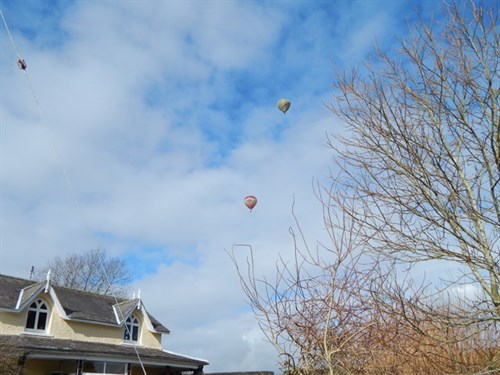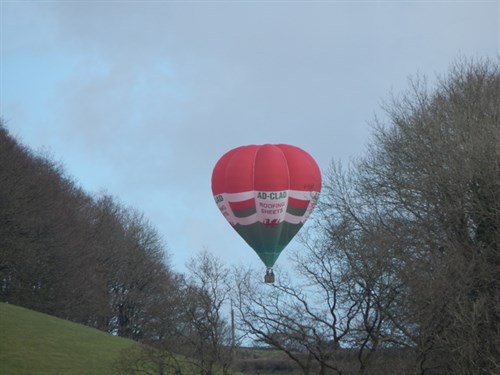Rain and gales continue throughout February and bring the "winter" to a conclusion
Tuesday, March 4, 2014
By my reckoning we have had almost 70 consecutive days when in
any 24 hour period there has been some rain, often torrential. It
is all getting too much; add to that the frequent severe gales and
it presents a very depressing picture. We have however fared better
than many other parts of the UK and that is something for which to
be grateful. It is officially the wettest winter for over 200
years! But it has also been very mild with just one frost in the
month. and this is what has kept us sane!
Some weather related pics:-
Aberaeron harbour, Ceredigion, the day after the great
gale on 12 February
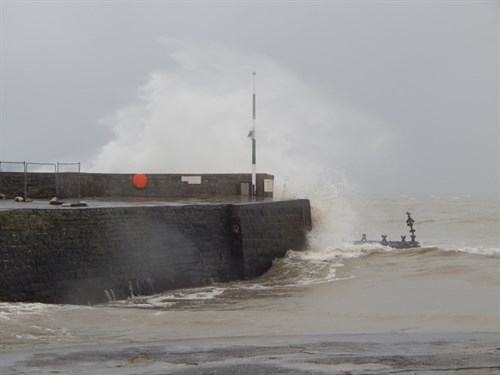
And the harbour looking inland towards the town
with its wonderful Georgian buildings
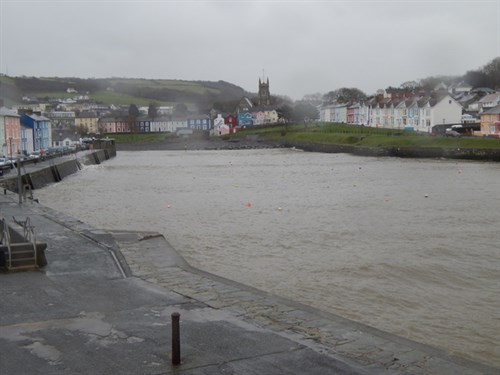
The river in spate at the bottom of the garden at
Cilgwyn Lodge
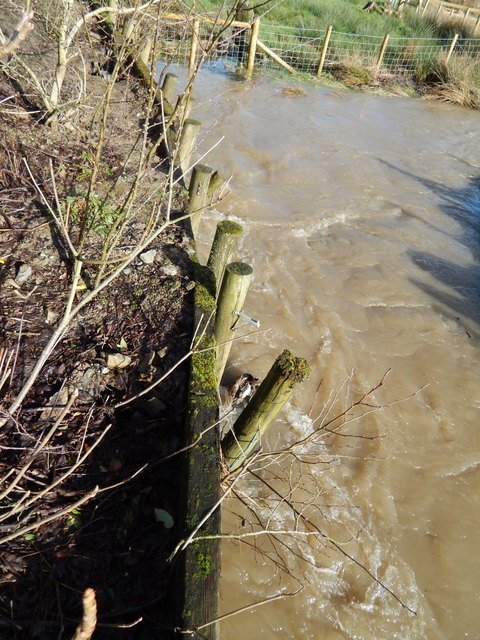
The barometer setting scarcely moved off the
lowest reading on the scale all throughout the month

There are many reasons to be cheerful nonetheless. The grass is
green, there are lambs back in the surrounding fields, in drier
interludes the birds are singing again, the frogs are back in the
Paddock Pond and growth is evident in the sodden flower beds.
Snowdrops have had a wonderful flowering and the beloved hellebores
are putting on a show but some have been badly battered by the wind
and the constant wet has brought a higher incidence of blackspot
than usual.
A very good unknown form of a tall snowdrop with
delicate green tips
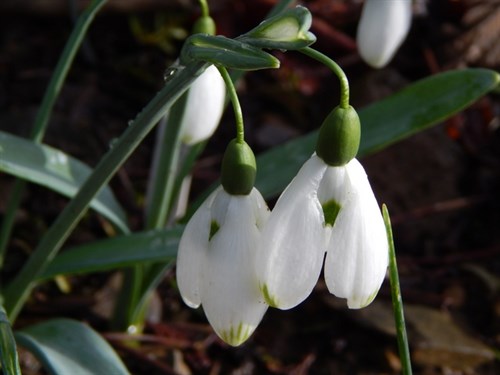
The best yellow hellebore I have ever seen from
Credale Nursery. See "Visits" for more info.
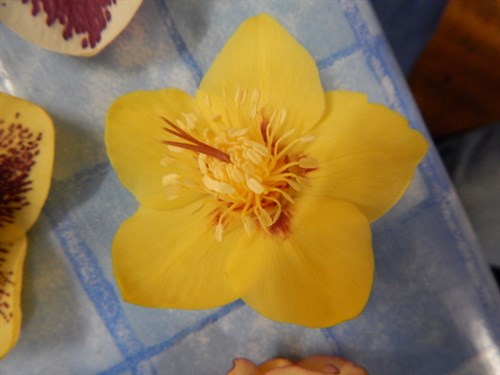
It lifts the spirits every day to see the flowers in the Beech
Hedge Walk which is our main late winter/early spring border,
lifted even further by the large clumps of cyclamen coum which have
bulked up over the course of the last 20 years.
Part of the Beech Hedge Walk in full bloom
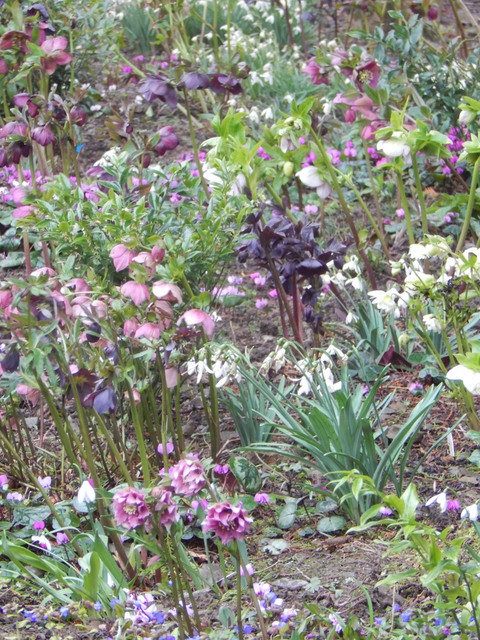
Whilst it is difficult to plan a work schedule for the garden
there is always work to do in the nursery poytunnels and frames,
and we are ahead of where we usually are at this time of year. It
has for the most part however been a very challenging month. When
the sun occasionally shines it brings to mind some words written in
a piece of prose by Dylan Thomas first broadcast in 1953 entitled
"The International Eisteddfod". It perfectly encapsulates the
indominantability of the human spirit and the joy of simple
celebration. "The town sang and danced as though it were right and
proper as the rainbow or the rare sun to celebrate the bright old
turning earth and its bullied people" The more things change, the
more they stay the same!
Weather
As this has already been done to death over the last 3 months I
won't linger but just to say that we had only one frost in February
on 16th of the month. Several other nights at just above freezing
but that was it - amazing! and very kind to the bank balance as
heating costs for the tunnel and greenhouse were much reduced.
There were at least 7 major storms mostly from the south east which
whips up our valley building up speed as the valley narrows. We
suffered more damage to the polythene on the small tunnel, already
damaged over the Christmas period and the end of one of the
glasshouses was blown out into the road in the most severe of the
gales on 12 February. Daytime temperatures of 9C and above were
common with a max of a balmy 12C on 24th
Garden Update
The continuing bad weather has played havoc with our programme
of work for February. One of the main tasks is the cutting back of
all the dead foliage of the herbaceous plants and carting it away.
Easier with a hedge trimmer - it still takes at least 3 days, and
once this is done it is closely followed by an intense hand weeding
of all the borders, which can be upwards of a 7 day job. As always
it is the bittercress that causes the most concern as it is so
quick to produce seed that it can reproduce itself every month and
that is one heck of a lot of unwelcome seed.
As the borders are so wet we have not been able to do this yet
so attention has turned to repotting all the plants in the 4 large
frames in the nursery. In spite of the humidity and rain we have
lost very few plants and many have bulked up so well that they have
been split to produce more plants for sale to our summer
visitors.
In spite of the bad weather there are still a good few plants
coming into flower
A pulmonaria seed raised form in the woodland
garden
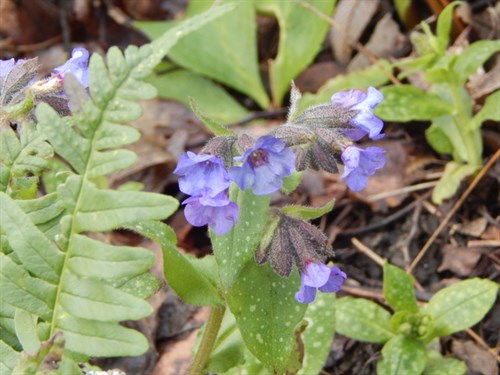
Euphorbia characias buds just about to open

And the same plant a week later
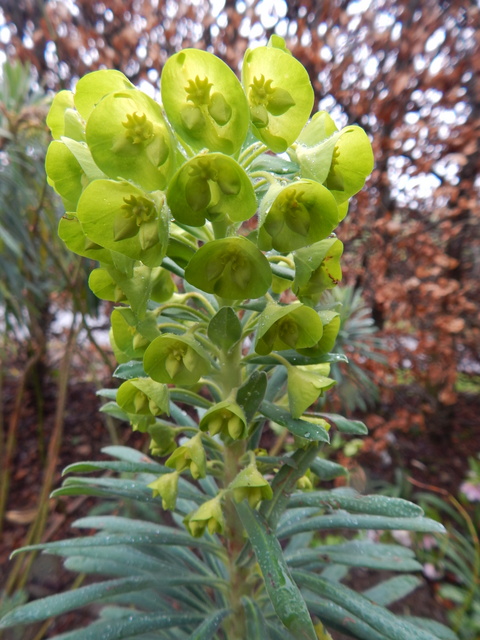
An unusual woodlander for damp shade, a member of
the saxifraga family, chrysosplenium macrophyllum
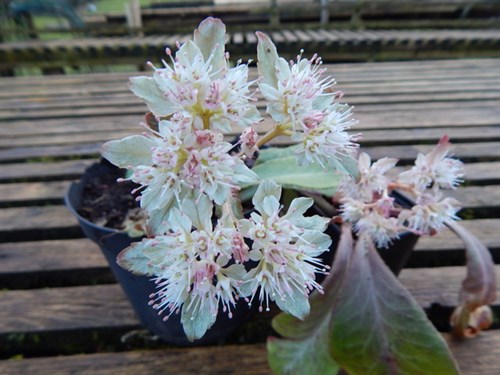
Seed sowing is an ongoing activity at this time of year and
already over 100 varieties of vegetable and flower seed have been
sown, many of which are growing away strongly and will soon need
pricking out. This is being delayed as long as possible because of
the shortage of space with having one tunnel largely out of action,
even though there are still some dry areas in which to hold hardier
more mature plants and to keep the bags of growing media dry.
I need a spell of calm dry weather to repair the small tunnel -
if it was just the polythene to replace it would have been done by
now - but with a major reconstruction of the existing frame,
setting new door frames in concrete and fixing at great expense an
aluminium ground rail to which to affix the new polythene (to save
digging a trench into heavily compacted and soaking wet ground) I
need much longer to complete the works and get the benching and
electrics ready to accommodate the more delicate seedlings and
cuttings which usually occupy the small tunnel at this time of
year. It is becoming more of a priority with each day that passes
but until the weather settles down I will not be able to begin the
job.
Fuchsia arborescens in the large tunnel just
coming into flower. In its native habitats in South America it can
grow into a mediun sized tree. Even in a tunnel it can make
exceptional growth in a relatively shorty space of
time

We continue to be largely self sufficient in vegetables direct
from the garden, freezer or in store. Recently the purple sprouting
a much loved and highly underated late winter crop has started to
come into production with sweet, intense purple spears. Regular
picking generates side shoots which produce yet more spears, A tall
and highly resilient plant it is a boost to the vegetable choices
at a time when production of the winter satlwarts like sprouts,
Purple sprouting ready for the first
cut
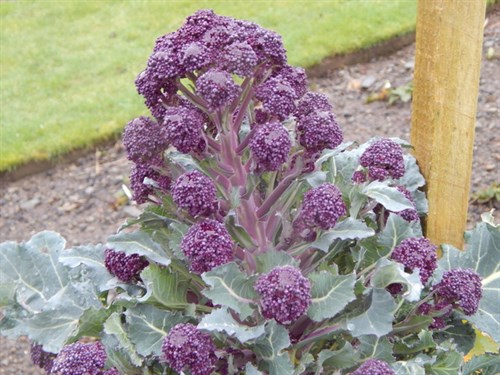
On a rare dry day earlier this month all the shrub roses (the
only sort we grow) were cut back by about half in most cases, with
a hedge trimmer. A simple, quick and highly effective means of
dealing with a task which, when using secateurs, can be a long
drawn out process and in my experience is no more effective or
productive.
What's looking good?
As always at this time of year the show stealers have to be the
hellebores. I know I keep on about them but they are in my opinion
without equal at this time of year. As they will grow almost
anywhere no garden should be without them! It isn't a vintage year
by any means as the continuous wind and rain has spoilt the flowers
of those in exposed positions but with more than 200 plants around
the gardens there are always plenty to admire. No other spring
flowering perennial can compete with them. I am pleased that some
of the species forms we have acquired over the past few years have
settled down well - in particular H. torqautus from Romania, H.
liguricus from Italy with a pronounced scent which could be
described as lemon but at other times smells more like cats pee!
H.odorus with good cup shaped green flowers is also a
scented form but not so pronounced as liguricus, and h.istriacus is
dainty with small green flowers. It is good to be reminded of the
charm and simplicity of true wild forms.
I promised more hellebore pics this month and here they
are!
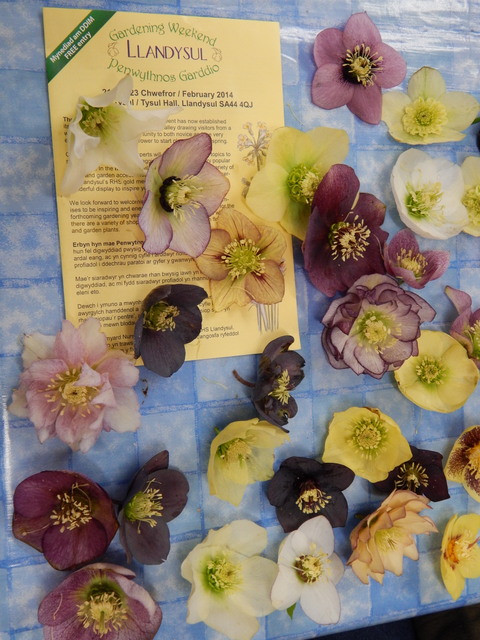
A wild collected h. torquatus from Romania with flowers
no larger than an inch across
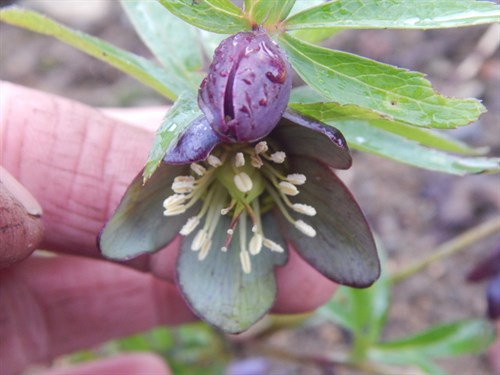
Another wild form H.istiacus from
Italy

A scented wild form h.odorus from central and
southern Europe

All the wild forms have played their part in the
hybridisation programmes that have been going on for the last 150
years and what some stunners they have produced!
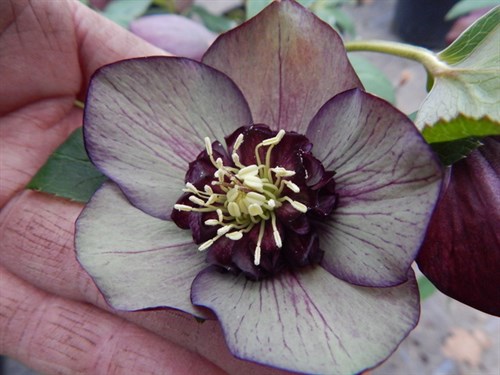
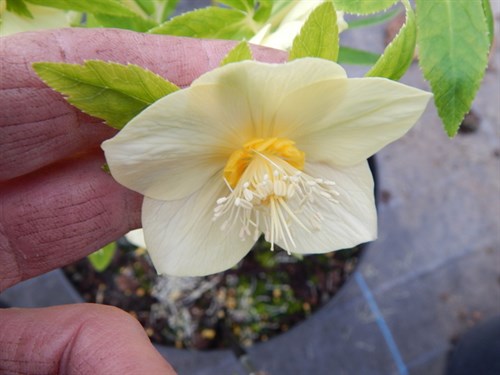


All the above are hybrids raised at Credale Nursery
Below are species and hybrid forms of the stemmed forms
of hellebores, different sections from those shown
above
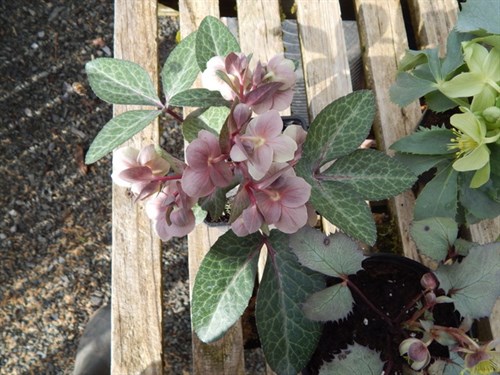
H.lividus a more tender form from Mallorca and
very rare there
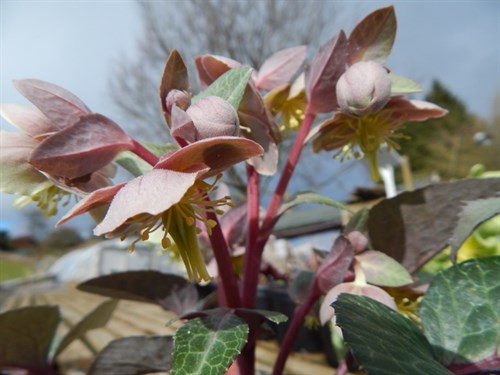
A selected form of h. argutifolius , "Silver
Lace"
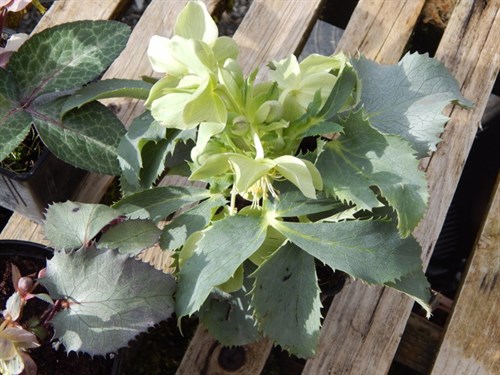
And a fine cross between the two, H.X Sternii
"Silver Dollar"
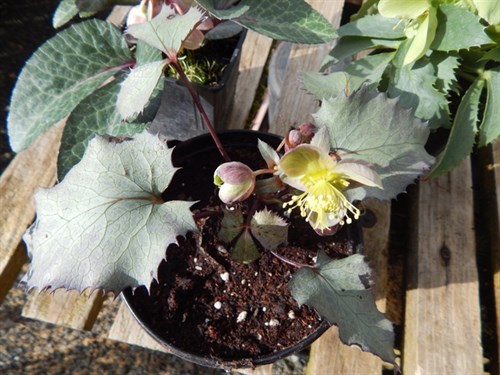
Cyclamen coum continue to flower well and we continue to add
more to our winter borders. As I have said before they are truly
hardy, unlike the smaller flowered cultivars from c. persicum
offered for sale in garden centres and other retail outlets in
winter. Although they are stated to be hardy, of course they are
not, except perhaps in a mild winter in larger townd and cities,
particularly in window boxes and protected planters. They have sold
well for us at talks I have given during the month.
Cyclamen at Cilgwyn

And a lovely planting of cyclamen with crocus,
ophiopogon planiscapus the so called black grass, all mulched with
broken slate at Ivycroft (see visits below)

Snowdrops have had a great flowering but are coming to an end;
anemone blanda is beginning to come into bloom as are narcissus
which considering the mild winter are later than usual with only a
few making it by St. David's Day, although in Swansea on the coast
they were in full bloom last week.
Narcissus "February Gold" just missed the deadline
coming into flower on 2 March!
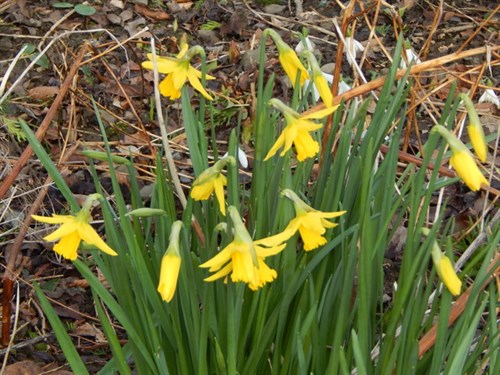
It is good to see herbaceous perennials starting to gow away
strongly especially phlox and lupins which have leaves that hold
water in in a jewel like fashion. Cornus mas with its yellow
flowers is slow this year but has started in the last couple of
days to show colour in ther bud.
Emerging leaves of phlox "Blue Paradise"
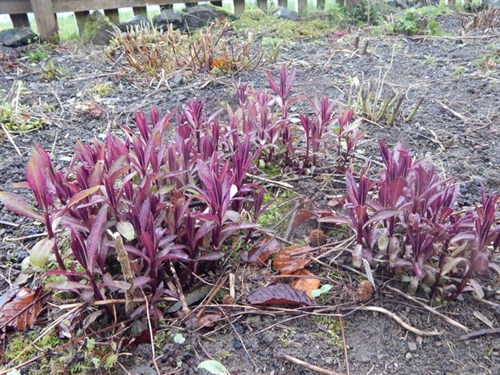
Lupin "The Governor" shining with droplets of
rain

Wildlife and countryside
The highlight in February is always the return of the frogs to
the Paddock Pond the first of which arrived on 17 February. A few
days later there were hundreds, filling the pond in no time with
masses of spawn, The noise they make is incredible which can be
heard over 30 metres away

There are still only a few lambs in the surrounding fields as
our farmer neighbours are having to keep them in the lambing barns
for longer because of the weather. Young lambs are very susceptible
to wind and rain.
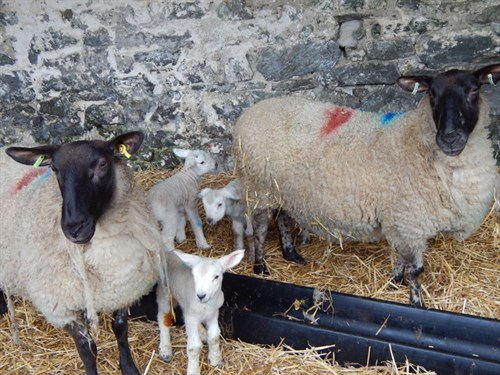
The flocks of starlings are diminishing although there was a
visitation in a small ash tree at the bottom of the garden which
looked almost like a scene from Alred Hitchcocks "The Birds"!!

There are a few celandines in flower in the gardens and plenty
more coming in the hedgerows
Visits
With 5 talks in the month it has been busy but very enjoyable,
all of them being well attended.
The Llandysul Winter Gardening Weekend was a success with over
40 in the audience for my talk on Vegetables on the Saturday There
were so many questions that I didn't get to the slideshow!! It
seemed to go well and I had some good feedback
The stage display at the Winter Gardening Weekend,
constructed by Farmyard Nurseries, Gold Medal winners at Chelsea
Flower Show

Other talks included "50 of my Favourite Hardy
Perennials", the most requested talk at present, and "Hooray for
Hellebores" a personal favourite, for Llangadog Gardening Club.
This meant that they have now had all my 8 talks. I am therefore
currently working to expand my talks portfolio with 2 new talks:
"Sizzling Summer Perennials" and "Gardens I Have Known and Loved"
both of which should be ready for autumn/winter 2014/15.
There were 4 visits to gardens and nurseries in the month. They
included Ivycroft, Ivington Green, near Leominster with a great
collection of snowdrops and other early flowering plants - go to www.ivycroftgarden.co.uk
Farmyard Nurseries www
farmyardnurseries.co.uk and Credale
Nursery for hellebores, www.credale.co.uk and a garden
in Overton, 6 The Boarlands on the Gower Peninsular
near Swansea a true "Plantsman's" garden with a staggering
collection of tender plants and many other rare gems. This garden
is open for the National Gardens Scheme on 26 July 2014 as part of
a village opening. Go to www.ngs.org.uk and follow the
links to Glamorgan, Overton and Port Eynon, entry no.23
Snowdrops at the entrance to Ivycroft
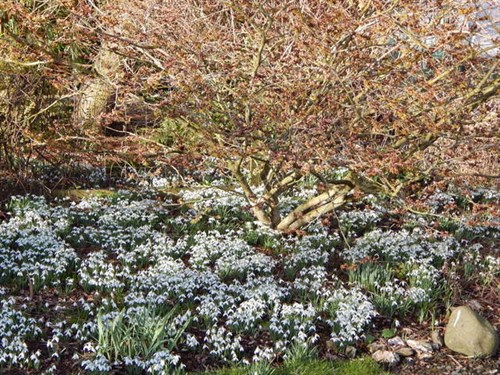
Snowdrop "Lady Elphinstone"
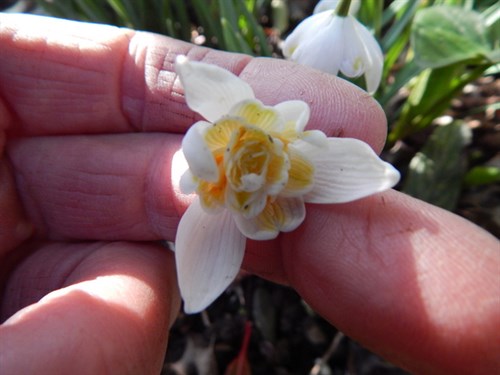
And a superb seedling from "Trym"
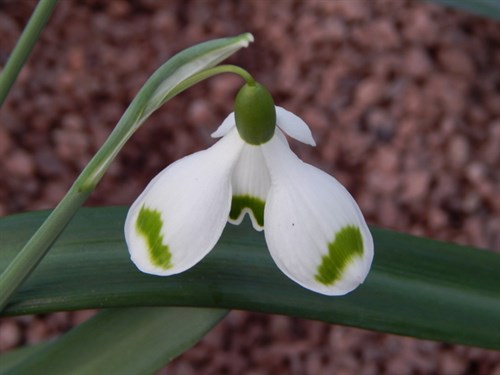
Echiums in variety at 6 The Boarlands
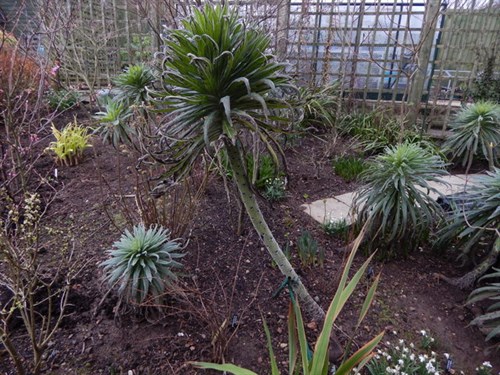
General border view

And not many can grow this demanding "Chatham
Island Forget Me Not" this well. It grows like a weed at Boarlands
with copious applications of seaweed
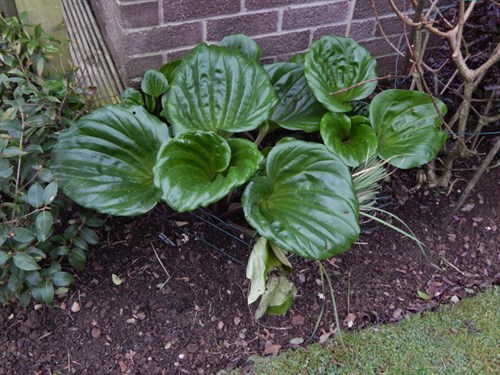
The stock tunnel and some choice hellebores at Credale
Nursery
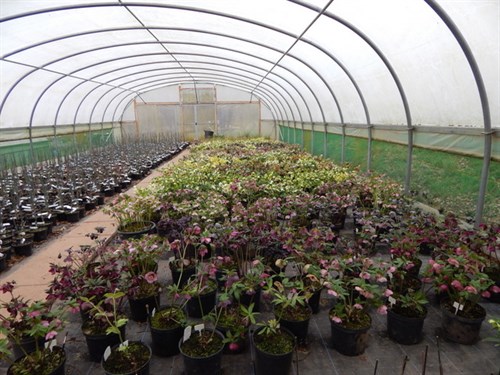
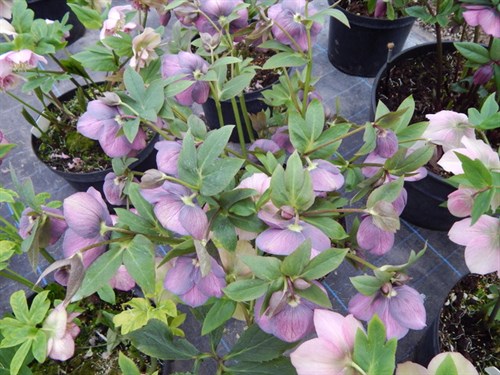
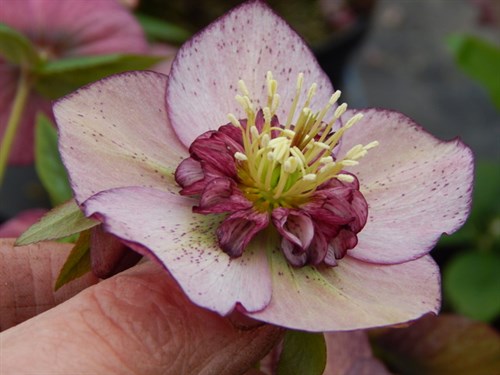
Another garden also open for the NGS we can heartily recommend
is Gelli Uchaf which has a wonderful spring garden 800
feet up in the hills of Carmarthenshire Go to www.thegardenimpressioni
sts.wordpress.com for visiting arrangements
Finally we already have several bookings for visits to Cilgwyn
Lodge this summer but there are plenty of other dates
available from June - end of August so if you would like to pay us
a visit please get in touch.
We had some unusual visitors for St. David's Day when a
number of hot air balloons flew directly over Cilgwyn. Note also
the BLUE! sky.
